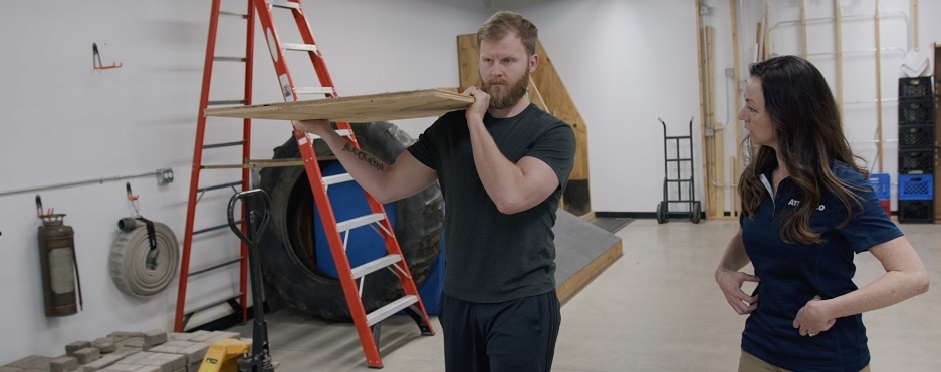
What is Work Conditioning and What Are the Benefits?
Leave a CommentWork conditioning is a somewhat misunderstood program. Some think it is for injured workers who have failed acute therapy, some believe it is the last chance before a patient reaches the end of care, and some assume it is acute physical therapy but with more lifting involved.
What Exactly IS Work Conditioning?
Work conditioning is a specific and functional program designed to help injured workers return to work and improve their abilities. In a work conditioning program, injured workers are assessed in regards to job demands, conditioning, and safety with job tasks. Injured workers can expect to participate in comprehensive baseline testing to determine current capabilities of the job demands. This is what is measured against for progress. A specialist builds a highly structured, goal-oriented work conditioning program for each injured worker’s job demands and current deficits. This is designed to bridge the gap between acute care and return to work without restrictions, improving strength, endurance, and positional tolerance necessary for a sustainable and efficient return to work.
How Does It Work?
Let’s use an example of an athlete who tore their ACL or rotator cuff. This athlete would have had surgery followed by acute care to rehabilitate their deficits in strength while monitoring the healing process. The athlete would have been involved in non-contact and sport-specific drills before being released to play in games at full speed. This has been standard practice for athletes for a long time. This is also true for an injured worker who tore their ACL or rotator cuff. You would never ask the athlete to return to full-contact sport before testing their abilities to play their position, getting them up to speed, and giving them the confidence to play again.
The same can be said about an industrial athlete, where work conditioning comes into play. Think of work conditioning as the athlete’s non-contact and sport-specific drills. The injured worker may still have some strength or motion deficits or perhaps they are deconditioned after being off work for an extended amount of time. Perhaps they are able to lift 50% of the weight they will be required to lift at work. The injured worker has likely already had acute care and has reached an appropriate healing time but is not yet ready to return to work at the level before their injury.
A Sustainable and Efficient Return to Work
At this point, a specialist will identify job demands and the patient’s deficits and build a specific program increasing tolerance to activity and the physical abilities needed at work, gradually building toward job-level performance. This program is intended to be as specific to each worker and their job demands as possible. Work conditioning programs help identify when a client has recovered appropriate physical abilities and allows them to regain confidence in their ability to perform their job. More improvements are made toward activity tolerance and return to job demands with care 4-5 times/week for several hours each visit. This timeline varies from acute physical or occupational therapy that traditionally occurs 2-3 times/week for 60-minute sessions.
What are the Benefits of Work Conditioning?
A work conditioning program gives the referring provider confidence in maximum improvement after interventions, the employer confidence that the injured worker can safely return to their job, and the injured worker confidence in their ability to perform job demands. This program and method of confidence-building can help eliminate guarding and poor technique that often plagues those who return to work without attempting job-specific activities at a job pace. Work conditioning can also help to reduce the likelihood of re-injury to the worker.
Get Started with Work Conditioning Today
Work conditioning should be on the radar for all injured workers to build confidence and avoid the possibility of extending care or incurring further injury.
The likelihood of an injured worker returning to work drops to 50% by the 12th week of leave; therefore, it is essential to transition appropriate patients through the continuum of care efficiently and effectively.1 At Athletico, we offer programs that support the return to work of injured workers while decreasing their risk for further injuries. To learn more, please visit www.athletico.com/EmployerSolutions.
The Athletico blog is an educational resource written by Athletico employees. Athletico bloggers are licensed professionals who abide by the code of ethics outlined by their respective professional associations. The content published in blog posts represents the opinion of the individual author based on their expertise and experience. The content provided in this blog is for informational purposes only, does not constitute medical advice and should not be relied on for making personal health decisions.
References
1. Ashley, Joe, et al. “Transition Back to Work – DOL.” Https://Www.dol.gov/Sites/Dolgov/Files/ODEP/Research/Saw-Rtw/TransitionBacktoWork_PoliciestoSuppor-tRTW_FINAL.PDF, IMPAQ International, 31 Aug. 2017, www.dol.gov/sites/dolgov/files/ODEP/research/saw-rtw/TransitionBacktoWork_PoliciestoSupportRTW_FINAL.
